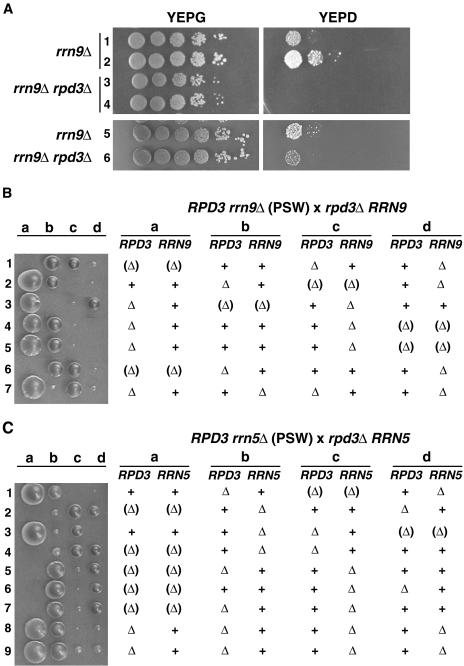FIG. 2.
rpd3Δ mutation inhibits appearance of PSW variants from N-PSW cells carrying rrn9Δ or rrn5Δ mutations. (A) RPD3 was disrupted in strain NOY2111 (rrn9Δ::HIS3; carrying helper pNOY199 and N-PSW). In one experiment, two colonies (colonies 3 and 4) of the resultant rrn9Δ rpd3Δ strain and two colonies (colonies 1 and 2) of its parent, NOY2111 (rrn9Δ), were analyzed for their ability to switch to the PSW state. In another experiment, disruption of RPD3 was repeated, and the rpd3Δ mutant isolated (rrn9Δ rpd3Δ colony 6) was analyzed together with a control rrn9Δ colony (rrn9Δ colony 5). An approximately equal number of cells (corresponding to a 2-mm-diameter colony) were picked from plates and suspended in H2O, and 10-fold serial dilutions of the indicated strains were spotted on YEPG and YEPD complete media. Plates were incubated for 7 days at 30°C. (B) Tetrad analysis showing rrn9Δ rpd3Δ spores without helper plasmid are inviable. Diploid cells (His+ Leu+) formed by crossing strain NOY684 (rrn9Δ::HIS3) with strain NOY2015 (rpd3Δ::LEU2) were sporulated, and tetrads were dissected and incubated for 9 days at 30°C. After a photograph was taken (shown), the colonies were analyzed for the presence of rrn9Δ (His+) and rpd3Δ (Leu+). The genotype of spores that failed to form colonies was deduced from the genotypes of colonies formed from the three other spores and concluded to be rrn9Δ rpd3Δ (shown in parentheses). We note that the colonies formed at the left-hand side of the photograph (e.g., spores a) were generally larger in size than those at the right-hand side (e.g., spores d) even if they had the same genotype, perhaps because they were farther away from the streak of zymolase-treated cells containing tetrad spores (the streak is not shown but is present to the right of spores d). (C) Tetrad analysis showing rrn5Δ rpd3Δ spores without helper plasmid are inviable. Diploid cells (Leu+ His+) formed by crossing NOY680 (rrn5Δ::LEU2) with NOY2156 (rpd3Δ::His3MX6) were sporulated, and tetrads were dissected and incubated for 9 days at 30°C. Colonies were analyzed as described above for panel B, and genotypes of haploid segregants are indicated. The genotype of the spores that failed to form colonies was concluded to be rrn5Δ rpd3Δ.

